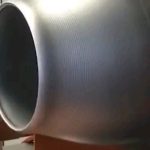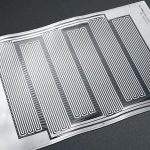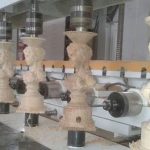Magnesium alloy is an alloy composed of magnesium and other elements. The main alloying elements are aluminum, zinc, manganese, cerium, thorium and a small amount of zirconium or cadmium. Magnesium-aluminum alloys are currently the most widely used, followed by magnesium-manganese alloys and magnesium-zinc-zirconium alloys.
1. Light weight, high specific stiffness and specific strength
The density of magnesium alloy is 1.74g/cm3, which is only 25% of that of cast iron and about 64% of that of aluminum alloy. It is the lightest material among the commonly used metals.
Although the specific gravity of magnesium alloy is heavier than that of plastic, the strength and elastic modulus per unit weight are higher than that of plastic. Therefore, in the case of parts with the same strength, magnesium alloy parts can be made thinner and lighter than plastic parts. In addition, since the strength of magnesium alloy is also higher than that of aluminum alloy and iron, the weight of aluminum or iron parts can be reduced without reducing the strength of parts.
Therefore, magnesium alloy is widely used in portable equipment and automobile industry to achieve the purpose of light weight.
2. Strong thermal conductivity
Although the thermal conductivity of magnesium alloy is not as good as that of aluminum alloy, it is dozens of times higher than that of plastic. Therefore, magnesium alloy is used in electrical products to effectively dissipate the internal heat to the outside of the shell.
For example, magnesium alloys are used on the housings and heat dissipation parts of computers and projectors that generate high temperatures inside, and magnesium alloys are used on the housings of TVs to achieve no heat dissipation holes.
3. Excellent electromagnetic wave shielding performance
The electromagnetic wave shielding performance of magnesium alloy is better than that of electroplating shielding film on plastic. Therefore, the use of magnesium alloy can save the electroplating process of electromagnetic wave shielding film.
4. Good impact resistance and compression resistance
Compared with other metals, magnesium alloy has greater resistance to deformation and better absorption of vibration energy. After being impacted, it can absorb impact energy without breaking.
Therefore, magnesium alloys are used for parts near vibration sources such as readout devices of hard disk drives, and magnesium alloys are used for fan blades to reduce vibration and achieve low noise. In addition, magnesium alloys are used for the steering wheel and seats in order to improve shock absorption and reduce weight after the car is hit.
5. Good machining performance
Magnesium alloys have lower cutting resistance than other metals, and can be processed at a faster speed during magnesium machining.
6. Good die-casting performance
The melting point of magnesium alloy is lower than that of aluminum alloy, and the die-casting performance is good. The minimum wall thickness of magnesium die casting parts can reach 0.5mm. Magnesium alloy has low affinity with iron during die-casting, less mold sticking phenomenon, and longer mold life than aluminum alloy.
7. Good dimensional accuracy and stability
Die castings have dimensional stability without annealing and stress relief. Die castings are cast with high dimensional accuracy and can be machined with high precision.
8. Good regeneration, can be completely recycled
Unlike plastics, magnesium alloys can be easily recycled without degrading their mechanical properties, whereas plastics are difficult to recycle without degrading their mechanical properties. Compared with other metals, magnesium alloy has a low melting point and small specific heat, and the energy consumed in regeneration melting is 4% of the energy consumed in the manufacture of new materials.
Disadvantages
1. Low corrosion resistance
The standard electrode potential of magnesium is low, and the oxide film formed on its surface is not dense, so the corrosion resistance is low. Therefore, magnesium castings often need surface oxidation treatment and paint protection.
2. Flammable and explosive
Magnesium is flammable, and magnesium liquid will react violently when it meets water, resulting in an explosion, and magnesium dust will also spontaneously ignite. Therefore, special safety protection measures should be taken in all aspects of magnesium alloy production.
3. Types of Magnesium Alloys
According to the forming method, it is divided into two types: wrought magnesium alloy and cast magnesium alloy.
There is a big difference between the two in terms of composition and tissue performance. Wrought magnesium alloys and cast magnesium alloys are classified according to their formability.
If the plastic deformation ability is strong, it can be formed by rolling, forging, extrusion and other forming processes that can produce plastic deformation to form a deformed magnesium alloy.
Cast magnesium alloys are not suitable for the above forming process and can only be formed by casting methods.
Magnesium alloys of the same alloy system with different alloy contents can be divided into cast magnesium alloys and wrought magnesium alloys. For example, AZ31 is a typical wrought magnesium alloy, while AZ91 is a cast magnesium alloy.
Wrought magnesium alloys have the characteristics of lower cost, higher strength, ductility and higher mechanical properties. Wrought magnesium alloys can be mainly divided into magnesium-lithium alloys, magnesium. Manganese alloys, magnesium-aluminum-zinc alloys, magnesium-zinc-zirconium alloys, etc. The strengthening mechanisms of magnesium alloys mainly include alloy strengthening, fine-grain strengthening, heat treatment strengthening, and deformation strengthening. The plastic machining technology is mainly extrusion, rolling, and forging.
Alloy name:
The alloy name of magnesium alloy is named after the main alloying elements and their percentages.
Such as: AZ91D CNC Machining
Surface Treatment
- 1. Passivation
- 2. Plating
- 3. Paint
- 4. Anodizing






